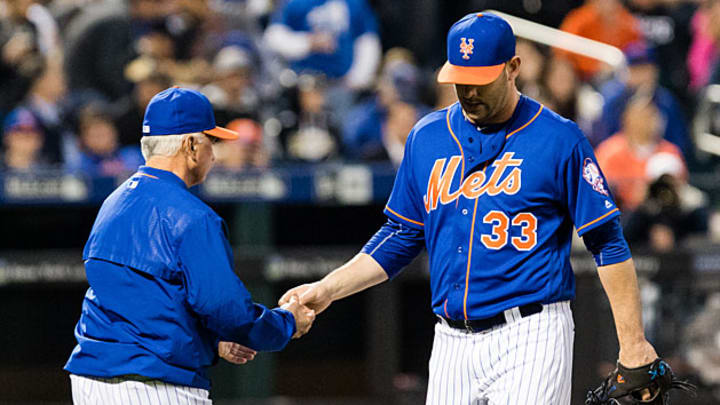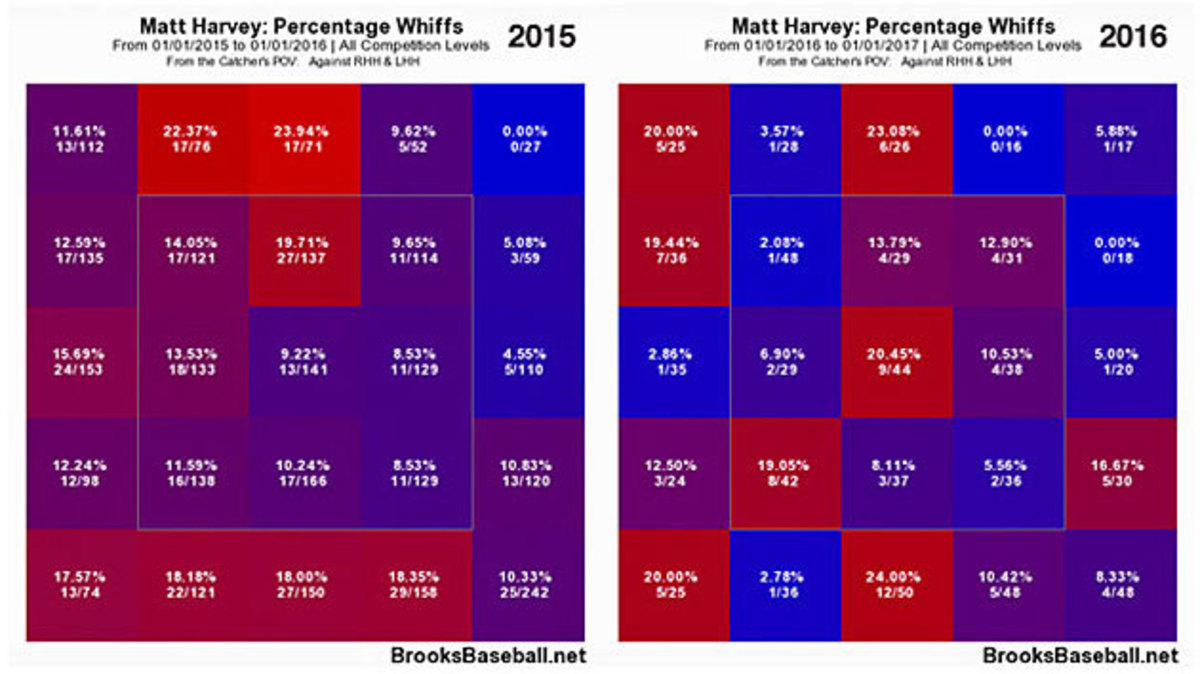What's wrong with Matt Harvey? Examining struggles of Mets' star

Get all of Jay Jaffe’s columns as soon as they’re published. Download the new Sports Illustrated app (iOS or Android) and personalize your experience by following your favorite teams and SI writers.
Thursday was a dark night for the Dark Knight. Pitching against the Nationals at Citi Field, erstwhile Mets ace Matt Harvey made the worst start of his major league career, exited to a chorus of boos and couldn't even get a commitment from New York manager Terry Collins that he'd make his next start on schedule because of his recent struggles.
Six days after giving up 11 hits and five earned runs in 5 2/3 innings at Colorado, Harvey didn't even make it out of the third inning against Washington. By the time Collins gave him the hook, he had allowed eight hits, two walks and nine runs (six earned) in 2 2/3 innings, throwing just 61 pitches. He served up a two-run homer to former teammate Daniel Murphy in the first inning, and after a scoreless second, retired just two of the 10 batters he faced in the third. After Ben Revere's two-run triple buried the Mets in a 9-1 hole, Collins came out to replace Harvey, and those with short memories among the 39,494 fans in attendance let the pitcher know of their dissatisfaction as he walked off the mound.
In his previous 73 major league starts, Harvey had never lasted fewer than four innings, thrown fewer than 65 pitches or given up more than seven runs. Had his dud been an isolated incident, he almost certainly wouldn't have been booed, but this season, Harvey has rarely shown the form that made him the Mets' Game 1 World Series starter last October. His 5.77 ERA is more than double his 2.71 mark from 2015 and he’s made just three quality starts out of nine thus far. To be fair, his strikeout and walk rates 8.0 and 2.8 per nine, respectively) are decent despite being off from last year (8.9 and 1.8). His 3.66 FIP suggests he's pitched much better than his record indicates, and indeed, he's been seared for a .390 batting average on balls in play, the majors' second-highest mark among qualifiers.

Perhaps some of Harvey's woes can be chalked up to simple bad luck and a lack of defensive support, but not all of them. Via Brooks Baseball, his average four-seam fastball velocity this season is 94.9 mph, well off last year's 96.5, and his offspeed pitches (curveball, slider and changeup) are each down by 1.6-1.7 mph. Relative to last year, he's getting substantially fewer whiffs per swing on three of his four pitches:
Pitch | 2015 Whiff/Swing | 2016 Whiff/Swing |
|---|---|---|
Fastball | 21.9% | 17.5% |
Changeup | 30.9% | 25.0% |
Slider | 38.5% | 31.3% |
Curveball | 35.8% | 37.9% |
What's more, he's getting fewer whiffs per pitch on those pitches—chosen here because the contrast is more apparent and the sample sizes larger than the above—in just about every segment of the strike zone; note the increasing amount of blue on the 2016 graphic:

As my colleague Cliff Corcoran noted a couple of weeks back, Harvey's struggles have largely come while pitching out of the stretch (i.e., with runners on base). With nobody on base this season, batters have posted a .731 OPS against Harvey, but that number jumps to .998 with runners on. Those represent huge increases compared to last season of 152 points (.579 in '15) with no one on base and 352 points (.673) with runners on. There is a similarly staggering increase in his BABIP. With no one on base it is .361 (an increase of 98 points over '15) and with runners on it is .415 (113 points higher).
The 30: What's luck got to do with this week's MLB power rankings?
Three of the five home runs Harvey has allowed have come with runners on base, compared to five out of 18 last year. Mets pitching coach Dan Warthen has suggested in the past that Harvey's woes stem from a mechanical issue whereby he collapses his back leg while pitching out of the stretch.
In his postgame comments, Collins pointed not to that issue but to the blood clot in his bladder that Harvey dealt with in March. Via NJ.com's Ryan Hatch, Collins said, "[Warthen] talked to me on the bench tonight and said, 'Ever since he had the thing in spring training he hasn't been the same guy. So, we're going to ... we have to certainly consider every angle we can."
That likely includes a trip to the doctor to make sure that Harvey is fully healthy, though the pitcher insisted that he is. While Collins reiterated his belief that Harvey would find a way out of his current struggles, he would not commit to having the 27-year-old righty make his next start in five days, saying, "We are going to look at that, take a look at the best thing. Is that the best for him? Is that best for us? We’re not going to commit to anything at this time.”
Inevitably, the big question that's been raised is whether Harvey's current struggles—particularly his loss of velocity—have anything to do with his workload last season, which was a topic of much debate among himself, his agent (Scott Boras) and the team. Instead of being shut down at 180 innings, as Harvey and Boras had indicated was the advice of Dr. James Andrews, Harvey pushed himself all the way to the fateful ninth inning of Game 5 of the World Series and finished the season having thrown 216 innings (189 2/3 regular season, 26 1/3 postseason). That marked the highest total of any pitcher in his first full season back from Tommy John surgery and was 37 2/3 innings higher than Harvey's previous career high, which was set in 2013 before he was sidelined by the torn ulnar collateral ligament that necessitated his surgery.
How White Sox ace Chris Sale learned to do more (and be better) with less
Here it's worth noting that Harvey isn't alone among the Mets' stable of starters in generating concerns that may be related to last year's workload. Jacob deGrom, though he's pitched to a 2.50 ERA, has struck out just 5.8 per nine (down from last year's 9.7 per nine), and his average fastball velocity is down more than two miles per hour from last year, from 95.8 mph to 93.6, with similar dips via his other pitches, and lower whiffs-per-swing rates. He missed two starts in April due to tightness in his latissimus dorsi and the post-birth complications of his newborn son, but his results have generally been solid. Noah Syndergaard and Steven Matz both recently had precautionary MRIs on their elbows, with the latter receiving a cortisone shot and skipping a turn, but both have been outstanding this year.
• Subscribe to get the best of Sports Illustrated delivered right to your inbox
Perhaps there's a link to Harvey's 2015 workload and his '16 struggles, but one interesting point to note is that both the observations of the SNY broadcasters (particularly former major league pitcher Ron Darling) and the PITCHf/x data at Brooks show that Harvey's release point this year has been a couple of inches higher than in the past, and generally higher in his bad starts this season than in his good ones. As the broadcasters noted, fatigue generally causes pitchers to lower their release points, though of course it's possible that Harvey’s woes stem from an attempt to overcompensate for fatigue.
Whatever the cause of his struggles, it's clear that the search for answers is only just beginning.
